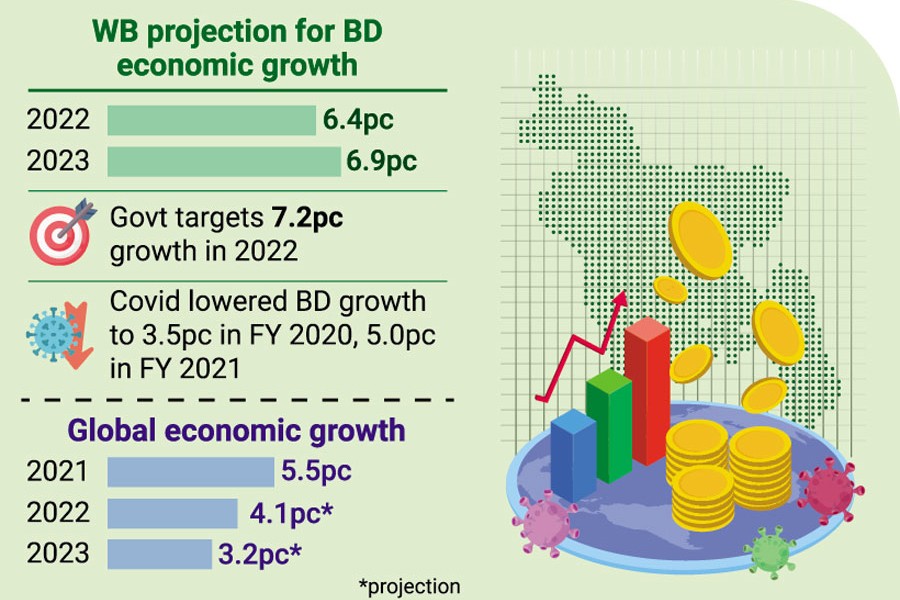
Belying a gloomy economic outlook across the corona-afflicted globe, the World Bank now forecasts an impressive growth for Bangladesh at a revised higher rate of 6.4 per cent.
In its Global Economic Prospect (GEP) report, released Wednesday (BST), the WB revises upwards Bangladesh's gross domestic product (GDP) growth from the level it had forecast six months before, now that the country's economic recovery is on stream.
The reset 6.4-per cent growth prospect is 1.3-percentage-point higher than its June 2021 projection.
"The strong export growth, supported by returning readymade garment demand from abroad, and a rebound in domestic demand -- with improving labor income and remittance inflows -- supported Bangladesh's recovery from the Covid-19 impact," says the GEP report.
The country's economy may increase even at higher rate in the next fiscal year (FY), 2022-23, as the WB predicts it to be 6.9 per cent.
Meanwhile, the Washington-based development financier forecast a lower global growth, likely decelerating markedly from 5.5 per cent in 2021 to 4.1 per cent in 2022 and 3.2 per cent in 2023, as pent-up demand dissipates and as fiscal and monetary support is unwound across the world.
For emerging and developing economies, the growth is also expected to drop from 6.3 per cent in 2021 to 4.6 per cent in 2022 and 4.4 per cent in 2023, the GEP report says.
The World Bank in its outlook says in Bangladesh, growth is projected to reach 6.4 per cent in FY2022, and 6.9 per cent in FY2023 with private consumption -- the main engine of growth -- supporting rise in services activity and firming exports of readymade garments.
"Both Bangladesh and Pakistan saw their goods trade deficit widen to record levels on strong domestic demand and rising energy prices," the WB says.
Bangladesh government has, however, taken a target to uplift the economy at a 7.2-per cent rate in the current FY2022.
After massive economic impact following the coronavirus onslaught, Bangladesh's surging economy faced a blow in the previous FY2020 and FY2021, as its growth dipped to 3.5 a per cent and 5.0 per cent respectively.
Meanwhile, the Asian Development Bank (ADB) has projected Bangladesh's GDP growth at 6.8 per cent in 2022.
The lender in its GEP shows that following a strong rebound in 2021, the global economy is entering a pronounced slowdown amid fresh threats from Covid-19 variants and a rise in inflation, debt, and income inequality that could endanger the recovery in emerging and developing economies.
The rapid spread of the omicron variant indicates that the pandemic will likely continue to disrupt economic activity in the near term.
In addition, a notable deceleration in major economies -- including the United States and China -- will weigh on external demand in emerging and developing economies.
The WB report also projects a possible impact of the inflationary pressure and a rising trend of income inequality across the global economies.
Rising inflation -- which hits low-income workers particularly hard -- is constraining monetary policy, it adds.
"Globally and in advanced economies, inflation is running at the highest rates since 2008. In emerging market and developing economies, it has reached its highest rate since 2011. Many emerging and developing economies are withdrawing policy support to contain inflationary pressures -- well before the recovery is completed."
At a time when governments in many developing economies lack the policy space to support activity if needed, new Covid-19 outbreaks, persistent supply-chain bottlenecks and inflationary pressures, and elevated financial vulnerabilities in large swaths of the world could increase the risk of a hard landing, the WB cautions.
"The world economy is simultaneously facing Covid-19, inflation, and policy uncertainty, with government spending and monetary policies in uncharted territory. Rising inequality and security challenges are particularly harmful for developing countries," says WB Group President David Malpass in a statement.
"Putting more countries on a favorable growth path requires concerted international action and a comprehensive set of national policy responses."
The slowdown will coincide with a widening divergence in growth rates between advanced economies and emerging and developing economies, the Bank says.
Growth in advanced economies is expected to decline from 5.0 per cent in 2021 to 3.8 per cent in 2022 and 2.3 per cent in 2023 -- a pace that, while moderating, will be sufficient to restore output and investment to their pre-pandemic trend in these economies, the GEP report said.
By 2023, all advanced economies will have achieved a full output recovery. Yet output in emerging and developing economies will remain 4.0 percent below its pre-pandemic trend.
For many vulnerable economies, the setback is even larger: output of fragile and conflict-affected economies will be 7.5 per cent below its pre-pandemic trend, and output of small island states will be 8.5 per cent below.
The latest GEP report also pinpoints three emerging obstacles to a durable recovery in developing economies -- firstly, unsustainable debt in developing economies, the implications of boom-and-bust cycles of commodity prices, and COVID-19's impact on global inequality.
© 2024 - All Rights with The Financial Express
